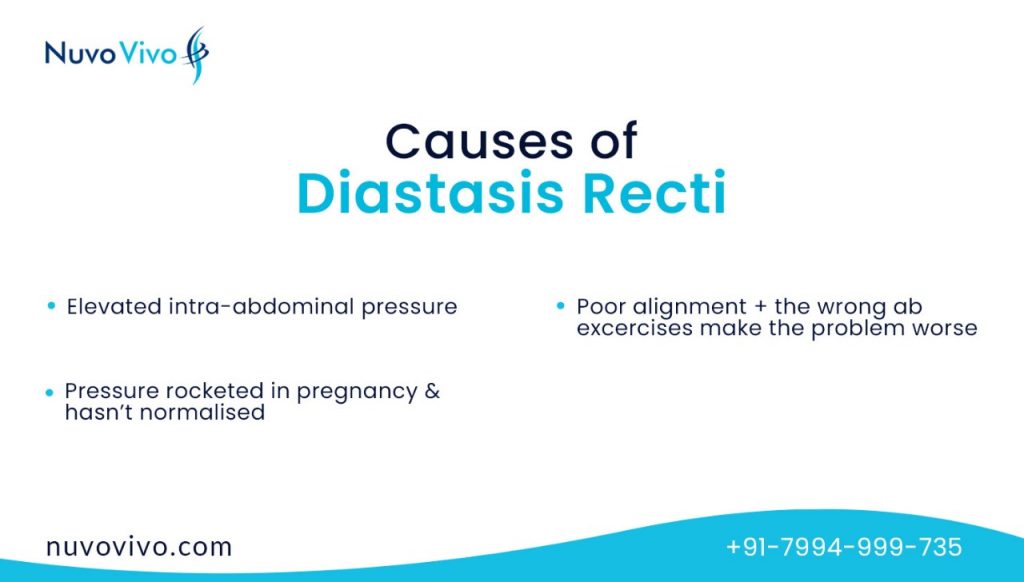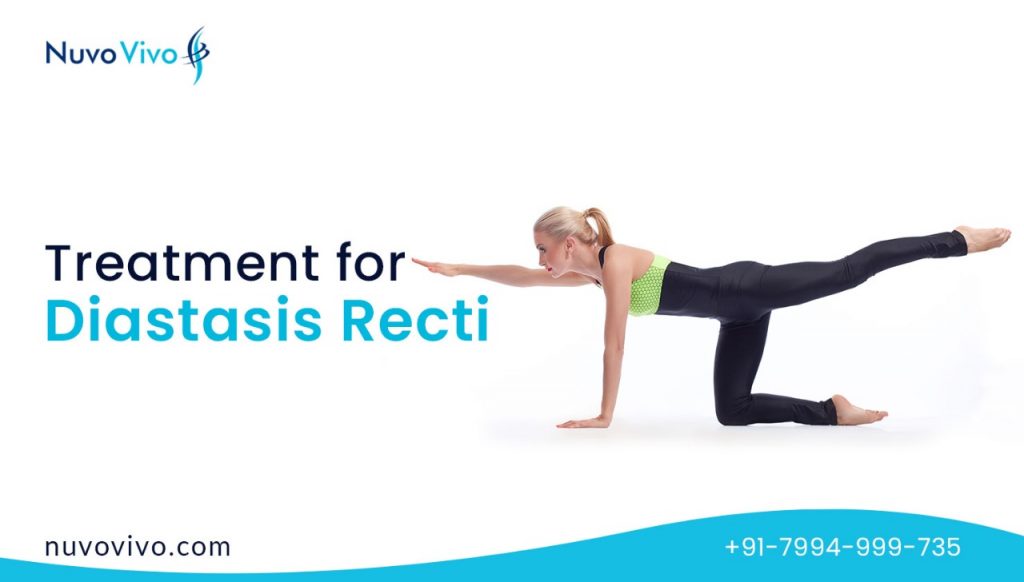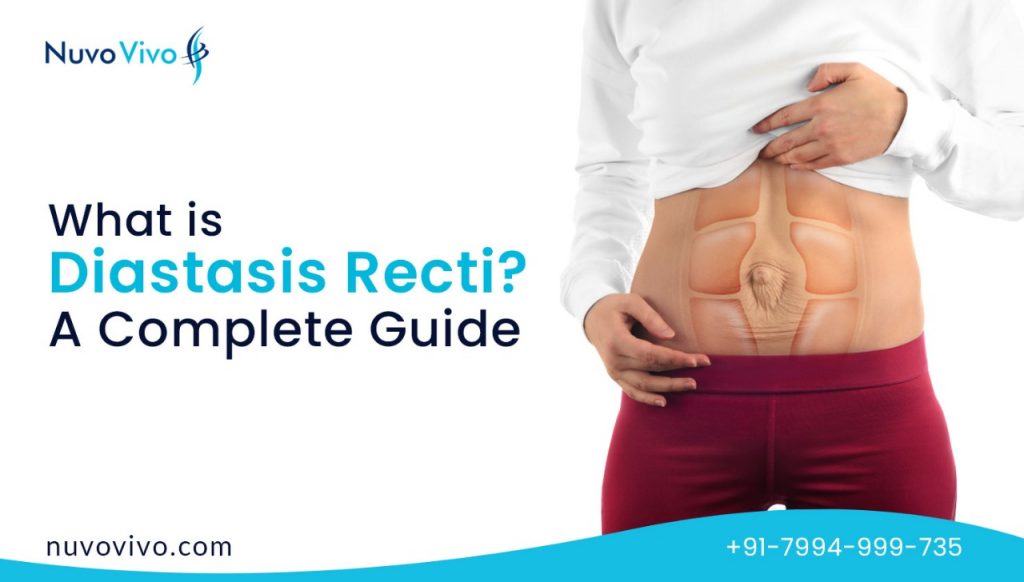A woman’s body goes through a crazy lot of physiological changes during pregnancy. Most of these changes are mediated by hormones, facilitate weight gain, increased heart rate, higher blood volume, altered metabolic parameters, and a lot more.
One among the most evident physical changes is, of course, the belly that grows bigger as the baby grows. This causes a lot of changes in the muscles around the core and abdomen.
Post-pregnancy, they are supposed to retract back to their original position. However, they do not do so in certain cases, causing ‘pooch belly’ and abdominal separation. This condition is called Diastasis Recti.
Our Abdomen Contains 4 Muscle Groups (See the pic below for reference):
- Rectus abdominis – Commonly known as “The Six Pack” – helps to move the body between the ribcage and the pelvis.
- Transverse abdominis – The deepest layer of the muscle. Stabilizes the trunk and maintains internal abdominal pressure.
- Internal obliques – Present on each side of the rectus abdominis, these muscles allow the trunk to twist to the opposite side.
- External obliques – Located inside the hip bones, these muscles allow the trunk to twist to the same side. For e.g., twisting to the left side will require left external obliques & right internal obliques.
Therefore, the abdominal muscles support the trunk, allow movement, and protect the viscera by holding organs in place.
These core muscles (deep abdominal muscles + muscles in the back) – keep the body stable and balanced. It is essential for maintaining proper posture, including stabilization of the pelvis and lumbar spine.
What is Diastasis Recti (Diastasis Rectus Abdominis – DRA)?
Diastasis Recti, also known as abdominal rectus diastasis, is a condition in which your “Rectus Abdominis Muscles” or your six-pack muscles separate, leaving a gap in between.
The fibrous band that is called Linea Alba separates the rectus abdominis. The space between these muscles is called inter-recti distance.
ALSO READ: Nutrition Plan During Pregnancy
Causes of Diastasis Recti

Ab separation can occur in people across age groups; however, it is largely seen in postpartum women.
During pregnancy, when the belly expands – Linea Alba (Connective tissue) stretches & separates the six-pack muscle group. This condition is noticeable right after delivery. Chances of diastasis Recti in women increase with multiple pregnancies.
The inter-recti distance usually gets resolved within 6-8 weeks of delivery, but in some cases, it may take up to 6 months, and in some cases, additional treatment is required. This condition also occurs in infants & aged men.
If infants are premature, the abdominal muscles are not fully connected and developed. Hence, babies may be born with Diastasis Recti.
The good news is that in infants, this condition resolves itself. Men may experience this condition in their 50’s/60’s and occur over the umbilicus.
Various factors could be responsible for this condition. Some reasons that are listed down in multiple studies are weight fluctuations, incorrect way of weight lifting, weak abdominal muscles, etc.
Basically, a regular increased amount of pressure on the abdominal muscles can lead to DRA.
ALSO READ: Pregnancy and Weight Gain
Symptoms & Diagnosis of Diastasis Recti
Now that you are aware of what diastasis recti is, and what causes diastasis. You may be curious about its symptoms, diastasis recti diagnosis, treatment for diastasis recti, etc.
Is diastasis recti dangerous? Is abdominal separation painful? Or How do you know if you have diastasis recti? A lot of questions like these may pop into your mind right now. Keep on reading to find answers to all of those doubts.
You may not even know that you have diastasis recti during pregnancy or even after delivery. However, this condition appears as a stomach bulge, which is one of the most noticeable diastasis recti symptoms, and in some cases, women may look pregnant too.
If you try to flex or tighten the abdominal muscles – you will feel the gap that is created due to the separation of the muscles. Sometimes this may get detected in the third trimester of the post-delivery period. If ever you feel that you might have signs of diastasis recti – do consult your doctor.
Ab separation is usually painless, but due to the separation of six-pack muscles, your abdominal muscles are left unsupported, which may also turn into a hernia.
DRA can also lead to other complications like –
- Lower Back Pain
- Bloating
- Constipation
- Pelvic / Hip Pain
- Urinary Leakage
- Incorrect Postures
DRA can be diagnosed by your doctor. However, if you lie down on a flat surface with bent knees – lift your head to do the half crunch; if you see two fingers width gap between the contracted abdominal muscles – you might have DRA.
Also, let your doctor do a physical examination to diagnose the condition. There are other methods through which ab separation can be diagnosed, e.g., calipers, CT scans, Ultrasound, etc.
ALSO READ: Core Muscles and Workout
Diet Plan For Diastasis Recti
Along with diastasis recti exercise, a proper diet may also help faster repairing of abdominal separation.
A healthy diet rich in vitamin C and A, zinc, protein, and iron may assist with collagen production and repairing damaged tissues. Eating foods high in dietary fiber and omega fatty acids can aid keep a clean and healthy digestive system.
Good nutrition is essential for the healing process of diastasis recti, just like with any other illness. But, a specific diet for diastasis recti or any particular food can’t be used as a replacement for diastasis recti treatment as healing does not hinge merely on a diet.
Always get advice from a doctor before undertaking a new diet plan.
ALSO READ: How to Control PCOS With Diet and Exercise?
Treatments & Care For Diastasis Recti

How to treat diastasis recti is a common query asked by many people who are trying to get rid of that “pooch” in their belly area.
Not everyone with DRA will need special attention. In some cases, especially in pregnant women, the body itself may correct the problem within a few months post-delivery.
Linea Alba (connective tissue) links the abdominal muscles back together, or muscles come closer enough to enable normal functioning of the core.
You may also take the help of corsets, binders, and postpartum bands to restore the natural core function.
However, if ab separation is not resolved naturally, physiotherapy is the only way to correct it as of now, but the effectiveness is not stated in any of the studies.
Various studies have confirmed that certain exercises performed during therapy sessions can have some positive influence on reducing DRA, but there are no set of exercises that have been formulated as of now which are considered as most effective.
Another option to get rid of DRA is going for surgery. As per a few experts, this method should be chosen only if therapeutic exercises for diastasis recti have not given any results, and the bulge is still there and is truly problematic.
Surgery is no small procedure, and you should consider post-surgery pain as well. Also, figuring out how to get rid of DRA is the requirement of bodily functions or purely appearance.
Make sure that you are consulting with your doctors before opting for any of the treatments for ab separation.
DRA patients are advised to avoid certain exercises as they may worsen the condition, including weightlifting or lifting anything heavy, pushups, planks, sit-ups, crunches, and any exercises that may increase the pressure on your abdomen.
Always ask for guidance from an expert before you get to indulge in any kind of physical activity that may pressurize your core.
Below are some of the exercises that can possibly help in improving the core strength and stability and also help correct Diastasis Recti.
Conclusion
Diastasis recti is a pretty common but curable condition. Certain exercises along with a proper diet can help to improve the ab separation symptoms. Surgery is another treatment option for extreme diastasis recti.
Ab separation after pregnancy usually gets better on their own in the first few weeks of postpartum. Talk to your healthcare provider about the symptoms and severity of the condition and opt for treatment accordingly.
Author Bio:

